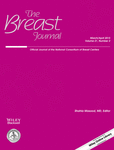Incidence of an Anatomically Separate Carcinoma of the Breast in Patients Diagnosed with a Papillary Lesion on Breast Core Biopsy
Monica Chung MD
Montefiore Medical Center and the Albert Einstein College of Medicine, New York, New York
Search for more papers by this authorTova Koenigsberg MD
Montefiore Medical Center and the Albert Einstein College of Medicine, New York, New York
Search for more papers by this authorNella Shapiro MD
Montefiore Medical Center and the Albert Einstein College of Medicine, New York, New York
Search for more papers by this authorCorresponding Author
Susan Fineberg MD
Montefiore Medical Center and the Albert Einstein College of Medicine, New York, New York
Address correspondence and reprint requests to: Dr. Susan Fineberg, Montefiore Medical Center and the Albert Einstein College of Medicine, New York, NY, USA, or e-mail: [email protected]Search for more papers by this authorMonica Chung MD
Montefiore Medical Center and the Albert Einstein College of Medicine, New York, New York
Search for more papers by this authorTova Koenigsberg MD
Montefiore Medical Center and the Albert Einstein College of Medicine, New York, New York
Search for more papers by this authorNella Shapiro MD
Montefiore Medical Center and the Albert Einstein College of Medicine, New York, New York
Search for more papers by this authorCorresponding Author
Susan Fineberg MD
Montefiore Medical Center and the Albert Einstein College of Medicine, New York, New York
Address correspondence and reprint requests to: Dr. Susan Fineberg, Montefiore Medical Center and the Albert Einstein College of Medicine, New York, NY, USA, or e-mail: [email protected]Search for more papers by this author
References
- 1Rizzo M, Lund MJ, Oprea G, et al. Surgical follow-up and clinical presentation of 142 papillary lesions diagnosed by ultrasound –guided core-needle biopsy. Ann Surg Oncol 2008; 15: 1040–7.
- 2Cuneo KC, Dash RC, Wilke LG, et al. Risk of invasive breast cancer and ductal carcinoma in situ in women with atypical papillary lesions of the breast. Breast J 2012; 18: 475–8.
- 3Degnim A, King TA. Surgical management of high risk breast lesions. Surg Clin N Am 2012; 93: 329–40.
- 4Lewis JT, Hartmann LC, Vierkant MAS, et al. An analysis of breast cancer risk in women with single, multiple and atypical papilloma. Am J Surg Pathol 2006; 30: 665–72.
- 5Shir-Hwa U, Mezzetti T, Tavassoli F. Papillary neoplasms of the breast: a review. Archiv Pathol Lab Med 2008; 133: 893–907.
- 6Estabrook A. Are patients with solitary or multiple intraductal papillomas at a higher risk of developing breast cancer? Surg Oncol Clin North Am 1993; 2: 45–55.
10.1016/S1055-3207(18)30593-3 Google Scholar
- 7London SJ, Connolly J, Schnitt SJ, et al. A prospective study of benign breast disease and the risk of breast cancer. JAMA 1992; 267: 941–4.
- 8Hartmann LC, Sellers TA, Forst MH, et al. Benign breast disease and the risk of breast cancer. N Engl J Med 2005; 353: 229–37.
- 9Brenner DJ. Contralateral second breast cancers: prediction and prevention. JNCI 2010; 102: 444–5.
- 10Dignam JJ, Wieand K, Johnson KA, et al. Obesity, Tamoxifen use and outcomes in women with estrogen receptor –positive early-stage breast cancer. JNCI 2003; 95: 1467–76.
- 11Gao X, Fisher SG, Emami B. Risk of second primary cancer in the contralateral breast in women treated for early-stage breast cancer: a population based study. Int J Radiat Oncol Biol Phys 2003; 56: 1038–45.
- 12Churpek JE, Walsh T, Zheng Y, et al. Inherited mutation in breast cancer genes in African American breast cancer patients revealed by targeted genomic capture and next-generation sequencing. J Clin Oncol 2013; 31: suppl abstr CRA 1501.




